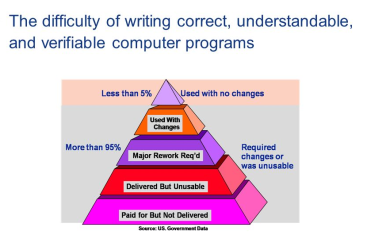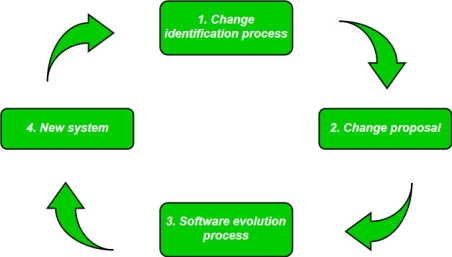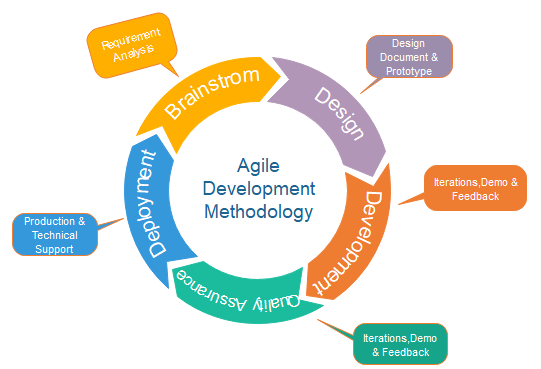UNIT 1
Introduction to Software Engineering & its history, Software Development Life Cycles
The term software engineering is coined with the addition of 'software + Engineering'.
Software is more than just program code. The program is a usable code, which serves a specific calculation purpose. Software is considered a collection of effective editing code, compatible libraries and texts. Software, when required for a specific purpose, is called product software.
Engineering, on the other hand, is about making products, using well-defined scientific principles and methods.
There are some definitions of software engineering provided by some famous authors:
(1) The use of a systematic, directed, unparalleled approach to software development, operation and maintenance; that is, the use of engineering in software. [By IEEE]
(2) German computer scientist Fritz Bauer described software engineering as: “Software engineering is the development and application of sound engineering principles to provide reliable and efficient software for real machines”

The difficulty of writing the code for a computer program which is correct and understandable is referred to as software crisis. The term software crisis revolves around three concepts: complexity, change and the expectations. This term was given by F. L. Bauer at the first NATO Software Engineering Conference in 1968 at Garmisch, Germany. Current System design approach is exceedingly empirical. It is unable to cope with increasing systems complexity. A number of problems in software development were identified in 1960s, 1970s, and 1980s. The problems that software projects encountered were: the projects ran over-budget, caused damage to property even to life. Despite our rapid progress, the software industry is considered by many to be in a crisis. Some 40 years ago, the term “Software Crisis” emerged to describe the software industry’s inability to provide customers with high quality products on schedule.
“The major cause of the software crisis is] that the machines have become several orders of magnitude more powerful! To put it quite bluntly: as long as there were no machines, programming was no problem at all; when we had a few weak computers, programming became a mild problem, and now we have gigantic computers, programming has become an equally gigantic problem.” – Edsger Dijkstra
Software Evolution is a term which refers to the process of developing software initially, then timely updating it for various reasons, i.e., to add new features or to remove obsolete functionalities etc. The evolution process includes fundamental activities of change analysis, release planning, system implementation and releasing a system to customers.
The cost an impact of these changes are accessed to see how much system is affected by the change and how much it might cost to implement the change. If the proposed changes are accepted, a new release of the software system is planned. During release planning, all the proposed changes (fault repair, adaptation, and new functionality) are considered.
A design is then made on which changes to implement in the next version of the system. The process of change implementation is an iteration of the development process where the revisions to the system are designed, implemented and tested.

Laws used for Software Evolution:
This law states that any software system that represents some real-world reality undergoes continuous change or become progressively less useful in that environment.
As an evolving program changes, its structure becomes more complex unless effective efforts are made to avoid this phenomenon.
Over the lifetime of a program, the rate of development of that program is approximately constant and independent of the resource devoted to system development.
This law states that during the active lifetime of the program, changes made in the successive release are almost constant.
Software is treated as a good software by the means of different factors. A software product is concluded as a good software by what it offers and how well it can be used. The factors that decide the software properties are divided into three categories: Operational, Transitional, and Maintenance. These are explained as following below.

1. Operational:
In operational categories, the factors that decide the software performance in operations. It can be measured on:
2. Transitional:
When the software is moved from one platform to another, the factors deciding the software quality:
3. Maintenance:
In this categories all factors are included that describes about how well a software has the capabilities to maintain itself in the ever changing environment:
Myths About Software Development
There are many myths and false assumptions that continue to loom around software development. Even though the first programming language, Fortran, was created in 1957 and the World Wide Web has eclipsed the quarter-century mark, software development is still viewed as some sort of dark magic, thus making people hesitant to embrace new technology. There are also lots of myths out there which prevent us from fully comprehending how business processes can be automated or improved by top quality programming which can lead to significant time and cost savings.
It is because of this myth companies do not harness the potential that custom software can provide which can improve their organization’s efficiency. Instead, they opt for purchasing some “one size fits all” solution which, of course, doesn’t fit their requirements and they have to find other means to work around it.
2. Users Have No Idea what they Know what they Want
Even though there conversely exists a myth that customers have no idea what they want until you show them, regardless, software companies need to be both product oriented and customer oriented as long as they consider the speed of delivery to be important. Wise businesses don’t simply focus on creating a top-notch, most innovative product on the market, but they also strive to deliver the best solution to the consumer, that provides market success. Doing no market research and not listening to your customers is simply not an option
\
3. The Waterfall Method Still Works
You would be amazed at the number of people who still believe that a system can be specified in detail, before you even build it. Not only is this almost impossible, but it is also inefficient to execute the development process in a sequence.
4. The More, the Merrier
Unfortunately, a myth exists that adding people to a development team makes it better and speeds up delivery. However, adding more people to a project tends to prolong the project’s timeframe and causes friction due to issues in training and collaboration.
5. Software Development has a Fixed Cost and Strict Timeframe
Going back to the Waterfall approach, it is simply not possible to detail out the software before building it. Even though a lot of companies are lured in by the fixed price model, they must also remember that there are some hidden costs associated with it in terms of quality and additional costs incurred as the project goes beyond the projected time boundaries.
6. When the Software is Released, the Projects is Over
As soon as the product is released, the focus should be on receiving feedback from the users and incorporating this feedback into an iterative approach back into the product. There needs to be an ongoing process of improvement and revisions along with testing for bugs in order to provide the customer with the best quality product.
7. A Requirement of Agile is that Product Owners and Developers Work in a Single Location
Thanks to modern communication technology, distributed teams can use collaborative tools such as e-mail, shared calendars, instant messengers, screen sharing, audio and video conferencing and many others to work together and stay up to date.
8. Outsourcing Solves Everything
Plain old outsourcing can create a far worse problem than you initially had. Software vendors should start thinking about establishing long-term relationships and engaging in a dedicated team model instead of fixed cost projects which lead to incomplete deliverables, frustration and high overhead costs.
A software life cycle model (also termed process model) is a pictorial and diagrammatic representation of the software life cycle. A life cycle model represents all the methods required to make a software product transit through its life cycle stages. It also captures the structure in which these methods are to be undertaken.

Software Development Process

The Code-and-Fix model
Code and fix model are another level ahead of the Big-Bang model. Identifies the product to be tested before release.
The testing team detects bugs and sends software to fix it. Bringing in the repair editors complete the installation of certain codes and send the software again for testing. This process is repeated until bugs are found in it, at an acceptable level.

Advantages of Code-and-fix model
This model is suitable for small projects.
It needs less project planning.
Disadvantages of Code-and-fix model
It is difficult to accommodate changes.
It is not clear what will be delivered and when.
It is difficult to assess quality.
The Waterfall model,
Winston Royce introduced the Waterfall Model in 1970. This model has five phases: needs analysis and specification, construction, implementation, and evaluation of units, integration and system evaluation, and implementation and maintenance. The steps always follow this way and are not consistent. The developer must complete all stages before the start of the next phase. This model is called the "Waterfall Model", because its graphic representation is similar to the fall of a waterfall.
Advantages of Waterfall model
This model is simple to implement also the number of resources that are required for it is minimal.
The requirements are simple and explicitly declared; they remain unchanged during the entire project development.
The start and end points for each phase is fixed, which makes it easy to cover progress.
The release date for the complete product, as well as its final cost, can be determined before development.
It gives easy to control and clarity for the customer due to a strict reporting system.
Disadvantages of Waterfall model
In this model, the risk factor is higher, so this model is not suitable for more significant and complex projects.
This model cannot accept the changes in requirements during development.
It becomes tough to go back to the phase. For example, if the application has now shifted to the coding phase, and there is a change in requirement, it becomes tough to go back and change it.
Since the testing done at a later stage, it does not allow identifying the challenges and risks in the earlier phase, so the risk reduction strategy is difficult to prepare.
The Incremental Implementation
An Incremental model is a software development process where the requirements are divided into multiple independent software cycle modules. In this model, each module goes through the stages of need, construction, implementation and testing. All subsequent release of the module can add function to the previous release. The process continues until a complete plan is found.
The various phases of incremental model are as follows:
Prototype Model
The model of software development where after each iteration prototype is shown to the customer for evaluation.
Steps of Prototype Model
Requirement Gathering and Analyst
Quick Decision
Build a Prototype
User Evaluation
Prototype Refinement
Engineer Product
Advantage of Prototype Model
Accurate user requirement
Suitable for unstable Requirement
Begins early product marketing
Reduce cost of Maintenance
Errors can be detected much earlier as the system is made side by side.
Disadvantage of Prototype Model
An unstable product becomes the final product
Require extensive customer support
Costly
Customer committed
May be too customer specific, no broad market
Difficult to know how long the project will last.
Easy to code and fix without proper requirement analysis, design, customer evaluation
Tools used expensive.
Special tools & techniques are used
It is a time-consuming process.
The Evolutionary Model
Evolutionary process model resembles the iterative enhancement model. The same phases are defined for the waterfall model occurs here in a cyclical fashion. This model differs from the iterative enhancement model in the sense that this does not require a useful product at the end of each cycle. In evolutionary development, requirements are implemented by category rather than by priority.
Spiral Model
The spiral model, initially proposed by Boehm, is an evolutionary software process model that couples the iterative feature of prototyping with the controlled and systematic aspects of the linear sequential model. It implements the potential for rapid development of new versions of the software. Using the spiral model, the software is developed in a series of incremental releases. During the early iterations, the additional release may be a paper model or prototype. During later iterations, more and more complete versions of the engineered system are produced.

Each cycle in the spiral is divided into four parts:
Advantages
High amount of risk analysis
Useful for large and mission-critical projects.
Disadvantages
Can be a costly model to use.
Risk analysis needed highly particular expertise
Doesn't work well for smaller projects.
Software Reuse
Software reuse is creating new system by combining existing components that have been used in other systems. Software engineering always emphasized on original development but now recognised to achieve better software, quickly at lower cost, with the help of systematic software reuse.
Benefits of software reuse
Critical Comparisons of SDLC models

1.4.3 An Introduction to Non-Traditional Software Development Process: Rational Unified Process, Rapid Application Development, Agile Development Process.
Rapid Application: RAD is a linear sequential software development process model that emphasizes a concise development cycle using an element based construction approach. If the requirements are well understood and described, and the project scope is a constraint, the RAD process enables a development team to create a fully functional system within a concise time period.
RAD (Rapid Application Development) is a concept that products can be developed faster and of higher quality through:

The various phases of RAD are as follows:
1. Business Modelling
2. Data Modelling
3. Process Modelling
4. Application Generation
5. Testing & Turnover
Agile Development Process
The meaning of Agile is swift or versatile. "Agile process model" refers to a software development approach based on iterative development. Agile methods break tasks into smaller iterations, or parts do not directly involve long term planning. The project scope and requirements are laid down at the beginning of the development process. Plans regarding the number of iterations, the duration and the scope of each iteration are clearly defined in advance.
